Is this chocolate cake recipe from Yotam Ottolenghi's baking cookbook Sweet the world's best?
Updated , first published

- More Yotam Ottolenghi baking recipes
- Meet Helen Goh, the Melbourne woman Ottolenghi is sweet on
- Jump straight to the chocolate cake recipe
Here is an image that I can't shake: It's a Sunday afternoon, around four, probably. My husband, Karl, looks out the window of our first-floor West London flat; an expression of clear foreboding appears on his face and then, very quietly, he says, "Helen's here – with her cakes."
Helen Goh then walks through our front door like a gust of wind or, rather, an overzealous dusting of icing sugar, carrying more cartons than humanly possible and, before even setting them down, begins apologising for all the things that went wrong with her cakes. This one hasn't risen properly, the other bowed around the centre, an icing has split during its application, a sabayon lost its air, a sorbet failed to churn, a sugar syrup crystallised, a cookie crumbled and so on and on and on.
Helen is an old friend and colleague who came to the Ottolenghi shops fresh off the proverbial boat from Australia, back in 2006. I remember meeting for the first time outside one of our shops, big meringue piles looming above us. I heard her story but couldn't quite understand what drives such a star to leave behind a very successful career – Helen is both a talented pastry chef and a successful psychotherapist – in a very sunny Melbourne in favour of a rather elusive future in a rather grey London.
It took seeing Helen at work – first on the savoury side of the kitchen, then on the pastry side and then, later still, spending much of her time dreaming up pastries, cakes and all manner of sweet things for the company – for the penny to drop. I finally realised that it was Helen's restlessness and her insatiable drive for perfection that had brought her to me.
What we shared was the notion that there is no upper limit to the number of times you can bake a cake or the amount of thought that can go into the components of a tart in order to get it just right; that you can discuss the minutiae of a chocolate ice-cream or a nut brittle as if the fate of the entire universe rests on the conversation, without worrying for a second that this may be, just maybe, a tiny bit over the top.
Baking brought out both our inner kids – and, also, our inner geeks, with all the precise measuring, timing and weighing that informed all of our chats. The combination of the child whose enthusiasm never wanes and the nerd who won't rest until it's perfect led to some pretty sweet results.
Officially, she's a "product developer" for Ottolenghi, but that doesn't really do her role justice; her originality and perfectionism have had an enormous impact on what we do. From Australia, she brought wonderfully crumbly and sharp yo-yo cookies, her billowy powder puff cakes that are just impossible to put down, and her chocolate cake, which is the cake grown-up kids dream of, and which [Melbourne's The Sunday Age] newspaper once called "the world's best" (pictured).
Her Malaysian heritage came through loudly in her chiffon cakes and pandan-infused pineapple tarts, which we often placed on the counter alongside our mince pies around Christmas. Her fluency in European and American baking traditions are there everywhere, from the almond-and-aniseed nougat bars piled by the register to our cheesecakes, cupcakes, madeleines and scones, which all sit beside the cakes I grew up eating, like the syrup-soaked semolina cake here.
Because I am a pastry chef myself, and a notoriously sweet-toothed being with an insatiable appetite for cakes, my bond with Helen was immediate and firm. We spent the following decade conjuring up an enormous variety of sweet things. Eventually, all these led to Sweet, the cookbook Helen and I have been working on for the past three years, which is also my first book dedicated solely to sweets. The Sunday tastings at home were forerunners to our Wednesday tastings for the book, which happened in my test kitchen in Camden, North London. Similarly, they were long and intense, sugar being both the fuel enabling us to carry on and the focus of our in-depth discussions.
Still, as much as we adhered to the old Sunday format, I must say that our capacity to consume sugar and abandon ourselves in cake conversation isn't quite what it used to be. I suspect it has to do with the fact that we both became parents in recent years. In our first meeting after Helen's son Sam was born, the three-week-old was resting in his Moses basket next to us while Helen and I were debating the merits of different consistencies of marshmallow for making s'mores. To my regret, I sent an offhand tweet reporting that an infant is the third wheel in our regular tastings, only to receive a bunch of grave warnings from concerned followers about the fatal risks of feeding cakes to newborns.
Setting aside this particular mishap, the arrival of Sam and his brother, Jude, and later on the birth of my boys, Max and Flynn, did slightly alter the nature of our tastings. Our attention now has to be harnessed and somewhat focused; deliberations are shorter.
Children's birthday parties are now natural testing grounds for sponges, and the boys are some of our fiercest critics. Just the other day I offered Max, now four years old, a slice of cake, to which he quickly replied, "Did Helen make it?"
"I am afraid not," I said.
"No, then," was his resolute and final answer. What a few years back may have been a very lengthy discussion was over before it had even started.
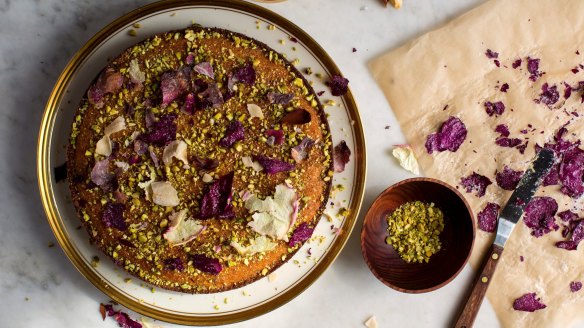
Pistachio and rosewater semolina cake (as seen on MasterChef Australia)
For the candied rose petals (optional):
1 large egg white
About 40 medium pesticide-free red or pink rose petals (from about 2 roses)
1½ tbsp sugar
For the cake
150g shelled pistachios, plus 1½ tbsp, finely chopped, for serving
½ tsp ground cardamom
100g almond meal
170g fine semolina flour
1¼ tsp baking powder
¼ tsp salt
300g unsalted butter, at room temperature and cubed, plus extra for greasing the pan
330g sugar
4 large eggs, lightly beaten
finely grated zest of 1 lemon (about 1 tsp), plus 3 tsp lemon juice
1½ tbsp rosewater (not rose essence)
½ tsp vanilla extract
For the rose cream
190g plain Greek yoghurt
200g creme fraiche
3 tsp icing sugar
3 tsp rosewater
For the rose syrup
120ml lemon juice
80ml rosewater
100g sugar
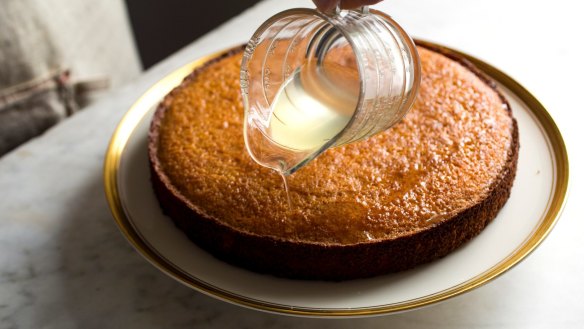
1. Heat oven to 100C. Line a baking tray with baking paper and grease a 23cm round springform tin and line with baking paper.
2. Make the candied rose petals, if desired: Whisk egg white by hand until frothy. Then, using a small pastry brush or paintbrush, very lightly paint both sides of each petal with egg white; do this in a few small batches, brushing and then sprinkling the sugar lightly over both sides of each petal. Shake off excess sugar and lay petals on the lined baking sheet. Place in the oven for 30 to 45 minutes, until dry and crunchy, then set aside to cool.
3. Make the cake: Increase oven temperature to 180C.
4. Combine pistachios and cardamom in a food processor. Process until the nuts are finely ground, then transfer to a bowl. Add almond meal, semolina, baking powder and salt. Mix together and set aside.
5. Place butter and sugar in the bowl of an electric mixer fitted with the paddle attachment. Beat on medium-high speed until fully combined, but take care not to overwork it; you don't want to incorporate a lot of air into the mixture. With the machine still running, slowly add eggs, scraping down the sides of the bowl a few times and making sure that each batch is fully incorporated before adding the next. The mixture will curdle once the eggs are added, but don't worry; this will not affect the end result.
6. Remove the bowl from the machine and add the dry ingredients, folding them in by hand and, again, taking care not to overmix. Next fold in lemon zest, lemon juice, rosewater and vanilla extract and scrape the batter into the tin. Level with an offset spatula and bake for 55 to 60 minutes, or until a skewer inserted into the centre of the cake comes out clean but oily. While the cake is in the oven, make the rose cream: Place all the ingredients for the cream in a bowl and whisk to beat everything together for about 2 minutes, until thick. Keep in the fridge until ready to serve.
7. Make the rose syrup: About 10 minutes before the cake comes out of the oven (you want the syrup to be warm when the cake is ready), place all the ingredients for the syrup in a small saucepan over medium heat. Bring to a boil, stirring so that the sugar dissolves, then remove from the heat. Don't worry that the consistency is thinner than you might expect; this is how it should be.
8. As soon as the cake comes out of the oven, drizzle all of the syrup over the top. It is a lot of syrup, but don't lose your nerve – the cake can take it! Sprinkle with finely chopped pistachios and set the cake aside in its tin to come to room temperature. Remove from tin and scatter rose petals over the cake. Serve immediately, with a generous spoonful of rose cream alongside. (The cake keeps well for up to five days in an airtight container. The rose petals should be sprinkled over just before serving.)
Serves 10 to 12
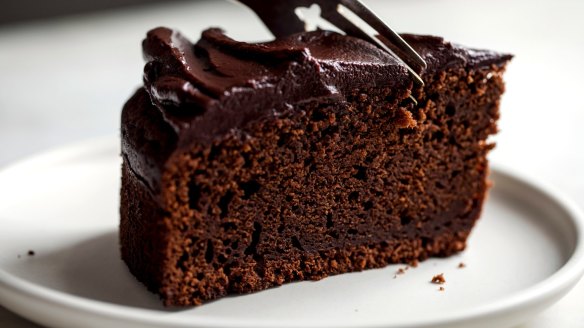
World's Best Chocolate Cake
For the cake
250g unsalted butter, at room temperature and cut into 2cm cubes, plus extra for greasing the pan
200g dark chocolate (70 per cent cocoa solids), chopped into 2cm pieces
1½ tsp instant coffee granules, dissolved in 350ml boiling water
250g sugar
2 large eggs, lightly beaten
2 tsp vanilla extract
240g self-raising flour
30g Dutch-processed cocoa powder, plus 1½ tsp, for dusting
¼ tsp salt
For the chocolate ganache (optional)
200g dark chocolate (70 per cent cocoa solids), broken or chopped roughly into 2cm pieces
200ml heavy cream
3 tsp golden syrup
3 tsp unsalted butter, at room temperature
For the espresso cinnamon mascarpone cream (optional)
375ml heavy cream
190g mascarpone
scraped seeds of 1/2 vanilla pod
2½ tsp finely ground espresso
¾ tsp ground cinnamon
1¾ tbsp icing sugar
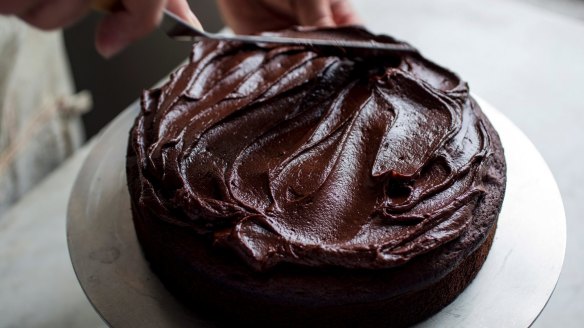
1. Heat oven to 170C. Grease a 23-centimetre round springform tin with butter and line with baking paper, then set aside.
2. Make the cake: Place butter, chocolate and hot coffee in a large heatproof bowl and mix well until everything is melted, combined and smooth. Whisk in sugar by hand until dissolved. Add eggs and vanilla extract and whisk again until thoroughly combined and smooth. Sift flour, cocoa powder and salt together into a bowl and then whisk this into the melted chocolate mixture. The batter here is liquid, but don't think you have missed something; this is how it should be.
3. Pour batter into the prepared pan and bake for 1 hour, or until the cake is cooked and a skewer inserted into the centre comes out clean or with just a few dry crumbs attached. The top will form a crust and crack a little, but don't worry, this is expected. Leave the cake to cool for 20 minutes before removing from the pan, then set aside until completely cool.
4. Make the chocolate ganache, if desired: Place chocolate pieces in a food processor, process until fine and set aside. Combine cream and golden syrup in a small pan and place over medium-high heat. As soon as bubbles begin to appear (just before it comes to a boil), remove from the heat. Get the food processor running again, with the chocolate still inside, and pour in the hot cream in a steady stream. Process for 10 seconds, then add butter. Continue to process until mixture is shiny and smooth. (You can also make the ganache by hand; just make sure the chocolate is chopped fairly finely before adding the cream mixture. Stir with a wooden spoon until almost melted, then add the butter. Stir again until the ganache is smooth.)
5. Use a rubber spatula to scrape the ganache into a bowl and cover with plastic wrap, with the plastic actually touching the top of the ganache. Set aside until it has set to the consistency you want. If you want a thin layer to spread over the cake, it can be poured over while liquid so that you get an even, light and shiny coating. For a thicker ganache with a spreading consistency, leave it for about 2 hours at room temperature. (The ganache can be stored at room temperature, providing it's not too warm, for 3 days or kept in the fridge for up to 2 weeks. It can also be frozen, although it will lose a bit of its shine when defrosted.)
6. Make the espresso cinnamon mascarpone cream, if desired: Place all the ingredients in the bowl of an electric mixer fitted with the whisk attachment. Beat for 1 to 2 minutes, until soft peaks form.
7. Peel the parchment from the cake and discard. Transfer to a serving platter and spread the ganache, if using, on top of the cake. Slice into wedges, divide the cake among plates and, if using, spoon the mascarpone cream alongside. With or without icing, the cake will keep well for 4 to 5 days in an airtight container.
Serves 12
© The New York Times
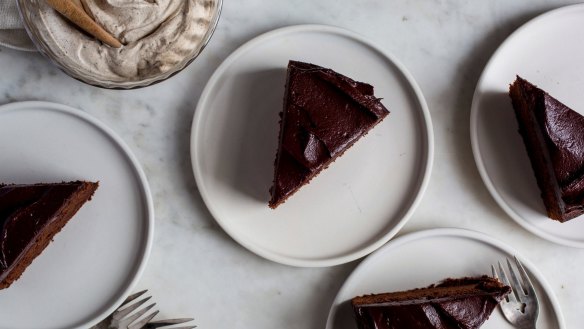
Appears in these collections
The best recipes from Australia's leading chefs straight to your inbox.
Sign up